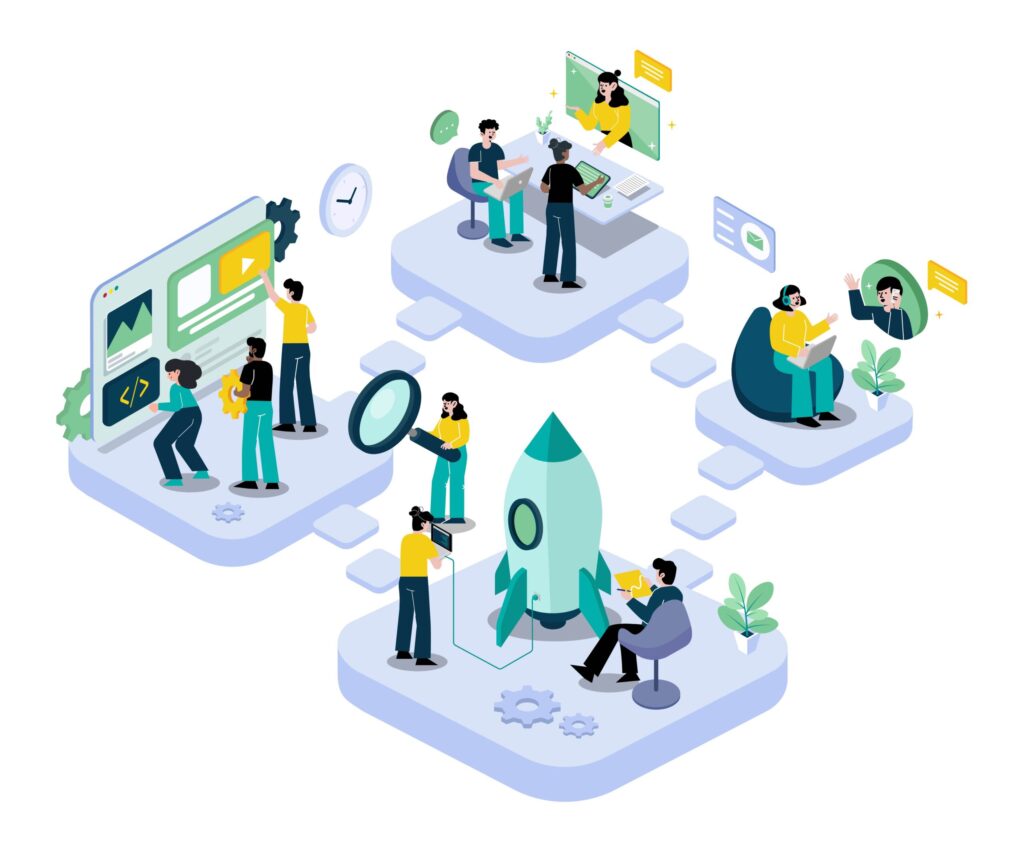The beauty of software is that you can shape it into whatever form you want. And today, if your business is online or has an app, then your business is made out of software. Which means you can reshape your business at will. Your options are limitless, but they are constrained – by money, by time, and by pay-off.
So you have a website, or an app. It’s software. You can make it do anything. What can you do with it to drive growth? What’s going to give you the pay-off you need?
Here’s the six main strategies for driving growth when your business is made out of software:
- Enter new markets,
- Expand product offerings
- Optimise specific channels,
- Enhance user experience,
- Personalisation
- Building trust and community
Which strategy you pursue, and how you implement it, is going to be unique to your business. But to help get you thinking about your options, we’re going to go through examples for each strategy and look at how well-known names approached it.
Enter new markets
Identifying and entering new markets involves understanding and catering to distinct user needs within different segments. For both B2B and B2C businesses, this means adapting or extending current offerings (see next section) to meet the unique demands of these newly identified user groups, thereby broadening your customer base.
Spotify looked outside of music to acquire podcasting companies like Gimlet Media and Parcast. This solidified their position in the rapidly growing podcast market and established a new revenue stream.
HelloFresh was initially focused on delivering meal kits with recipes and ingredients. Recognising a demand, they added a marketplace option with ready-to-heat meals and other grocery items, expanding their potential customer base.
Zoom was designed primarily as a video-conferencing tool for businesses. When the pandemic hit, they quickly adapted to serve the exploding need for remote communication in personal and educational settings, vastly increasing their market reach. They now offer Zoom One for Education for this new market.
The classic “Enter New Markets” story is Netflix. They started as a DVD-by-mail rental company and transformed into a streaming giant. They then expanded further by investing heavily in original content production, becoming a major player in the entertainment industry.
Expand Product Offerings
Expanding product offerings entails developing and introducing new features, services, or products that complement existing ones. This strategy aims to provide additional value to current users while attracting potential customers by broadening the utility and appeal of your business’s portfolio.
Slack had its start as a team messaging tool. By introducing features like Workflow Builder and Huddles for audio calls, they have transformed into a more comprehensive collaboration platform attracting a wider user base.
Headspace, the meditation app, added sleep stories, soundscapes, and guided focus music sessions. This greatly expanded the value proposition for subscribers, leading to increased engagement and retention.
Jira, by Atlassian, was originally an issue-tracking tool for software teams. Atlassian has continuously expanded its functionality and Jira now offers a range of products spanning project management, collaboration, and support functions, appealing to a broader range of business units outside of software development.
Notion started as a note-taking app, but it has evolved into a versatile workspace tool with databases, kanban boards, wikis, and, most importantly, teams for sharing and collaboration. This attracted users with diverse productivity needs.
Optimise Specific Channels
Optimising specific channels focuses on improving the efficiency and effectiveness of each point of contact your users have with you, so it is limited to businesses who have a mix of web and app products. The goal is to enhance reach, engagement, and conversion rates within these channels, ensuring that they are fully leveraged to achieve maximum impact.
Instagram introduced shoppable posts and integrated in-app checkout. This greatly reduced friction for e-commerce businesses operating on Instagram, boosting sales directly within the platform.
Pocket, the “save now, read later” service, implemented a “Listen” feature that offers text-to-speech conversion. This made their saved articles accessible even on the go or during multitasking, optimising for different use cases.
Venmo added a social element with a newsfeed of friends’ transactions (with adjustable privacy settings). This made the peer-to-peer payment app more engaging and fostered a sense of community.
Sephora developed augmented reality features for its mobile app, allowing users to virtually try on makeup products. This innovative feature directly boosted mobile sales and improved the shopping experience.
Enhance User Experience
Enhancing user experience is about refining the overall interaction users have with your business’s products or services. This involves streamlining interfaces, improving accessibility, and ensuring that the user journey is intuitive and satisfying, leading to higher engagement and satisfaction rates.
Shopify introduced its integrated point-of-sale (POS) system. This allowed merchants to seamlessly manage in-person and online sales, creating a smoother customer and merchant experience.
Uber introduced “upfront pricing” to replace surge pricing that was subject to fluctuation. This increased transparency and predictability, improving the user experience significantly.
Airbnb implemented a secure messaging system allowing guests and hosts to communicate directly within the platform. This streamlined communication and instilled a greater sense of trust.
Pinterest developed the “Lens” feature, allowing users to search using images snapped with their camera. This made product discovery and inspiration much more intuitive, keeping users engaged.
Personalisation
Personalisation involves tailoring the user experience and communication to individual preferences and behaviours. By leveraging data analytics, your business can create more relevant, engaging interactions that resonate with users on a personal level, fostering a deeper connection and improved response rates.
Stitch Fix, the online clothing styling service, employs machine learning algorithms to match customers with clothing items based on their style preferences and feedback. This hyper-personalisation creates a unique shopping experience and increases customer satisfaction.
Grammarly, the writing assistant tool, offers personalised suggestions based on the user’s writing style and goals (formal vs. casual, creative vs. technical). This customisation makes the product far more valuable to individual users.
Spotify’s “Discover Weekly” and “Daily Mix” playlists offer continuously updated selections, tailored to each user’s listening preferences. This exceptional personalisation keeps users hooked.
Duolingo, the language learning app, uses spaced repetition and gamification principles adjusted to each individual’s progress and learning style. This adaptive approach super-charges engagement in the language learning experience.
Building Trust and Community
Building trust and community centres on establishing credibility and fostering a sense of belonging among users. This can be achieved through transparent communication, reliable service, and creating platforms for user interaction and feedback, which in turn, strengthens loyalty and advocacy among the user base. This can make for a nice moat in a competitive market.
Tripadvisor implemented a system to highlight and reward top reviewers. This incentivized high-quality, reliable reviews and strengthened the platform’s reputation as a source of trustworthy information.
Hubspot, the marketing and sales software provider, hosts “Inbound,” a massive annual conference fostering networking and knowledge sharing. This establishes their thought-leadership position and strengthens brand loyalty.
Webflow, the no-code website building platform, runs a vast educational resource centre and community forum. This attracts and supports users of all skill levels, increasing adoption and reducing churn.
Conferensity’s Digital Growth Strategy
Have you met Conferensity? They’re our imaginary business we’re using to explain and demonstrate the topics we discuss.
Conferensity is currently a basic B2B event management platform. Their primary goal:
“To become a comprehensive conference solution and enjoy the increased market share and revenue possibilities this will create.”
Their strategy involves expanding their web-based software’s capabilities and developing two apps – one for conference admins and another for attendees.
While these are three digital products, 1 website and 2 apps, there is actually a fourth project – the updated backend that will implement the features the website and apps will provide interfaces for. This backend will also require extensive work to provide all the necessary admin features to manage the new frontend features.
Referring back to our list of growth strategies, Conferensity is expanding its platform and launching two new apps to broaden its appeal and functionality. This expansion will enrich the service for existing B2B clients and draw in new users by offering a more comprehensive set of event management tools.
The company is also overhauling its backend to support these new features. This upgrade is crucial for ensuring the system’s reliability and scalability, enhancing user experience across web and mobile platforms.
By developing apps for specific roles within the event ecosystem, Conferensity is reaching into new market segments, increasing user engagement, and extending its market reach.
Conferensity’s is pursuing personalisation and building trust by creating tailored features for different user groups.
Conferensity’s strategy is to do all the strategies. But that’s because it’s an example. However, the idea that a feature can be hitting multiple strategies is worth being aware of when you are making your choice amongst several growth options. That overlap can be a powerful multiplier.
Finding your own path to growth
So we’ve demonstrated the key strategies for digital growth: entering new markets, expanding products, optimising channels, enhancing user experience, personalising services, and building trust.
These strategies are not standalone; they often overlap, magnifying their impact. Our example of Conferensity’s plans for growth shows how these strategies are best pursued: blending some or all of them to reshape your business in order to generate the growth you’re looking for.












